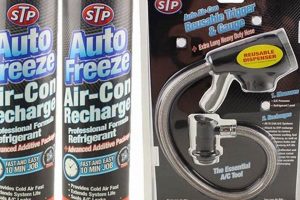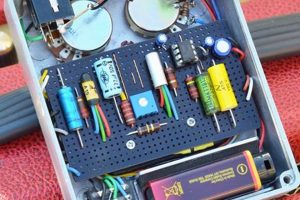These sets provide all the necessary components and instructions for individuals to assemble electronic circuits or projects themselves using solder. They typically include a soldering iron, solder, electronic components (resistors, capacitors, LEDs, etc.), a circuit board, and a detailed manual. An example of its usage is a beginner learning to build a simple LED flasher circuit.
The rise of accessible electronics education and hobbyist culture has fueled their importance. They offer a hands-on learning experience in electronics, fostering skills in circuit assembly, troubleshooting, and problem-solving. Historically, electronics assembly was a specialized skill, but these accessible tools have democratized the learning process, allowing for wider participation in electronics projects and innovation.
The following sections will delve into the essential components of these sets, explore considerations when selecting a suitable option, and provide guidance on effective usage for optimal results.
Essential Usage Tips
Effective utilization of these sets requires careful preparation and adherence to proper techniques. Following these tips can contribute to project success and safety.
Tip 1: Prioritize Safety: Always wear appropriate eye protection. Solder fumes should be ventilated adequately to prevent inhalation. Ensure the soldering iron is placed on a heat-resistant stand when not in use.
Tip 2: Prepare the Workspace: A clean, well-lit workspace is crucial. Secure components to prevent movement during soldering. Gather all necessary tools and components before commencing the assembly process.
Tip 3: Tin the Soldering Iron Tip: Before each soldering session, apply a small amount of solder to the tip of the iron. This process, known as tinning, improves heat transfer and facilitates a clean solder joint.
Tip 4: Apply Heat Simultaneously: Heat both the component lead and the circuit board pad simultaneously. Apply the solder to the heated joint, not directly to the soldering iron. This ensures a strong and reliable electrical connection.
Tip 5: Use the Correct Solder Type: Verify the type of solder included with the kit or purchase appropriate solder for electronics projects. Lead-free solder is often preferred for environmental and health reasons, but it may require a higher soldering temperature.
Tip 6: Avoid Overheating: Excessive heat can damage components and the circuit board. Apply heat for only a few seconds to create a sufficient solder joint. A shiny, smooth joint indicates a good connection; a dull or lumpy joint suggests a problem.
Tip 7: Inspect Solder Joints Carefully: After soldering, thoroughly inspect each joint for defects such as cold solder joints (dull appearance), solder bridges (unintended connections between pads), or insufficient solder. Use a magnifying glass for close examination.
Successful project completion relies on paying close attention to detail and implementing sound soldering practices. Consistent application of these techniques will improve the quality and reliability of assembled electronics.
The next section will provide guidance on troubleshooting common issues encountered during assembly and offer solutions to ensure project completion.
1. Component Identification
Component identification forms the bedrock of successful assembly of these sets. The kits contain a variety of electronic components, each with specific functions and values. Incorrect identification can lead to circuit malfunction or even component damage. For instance, placing a resistor with the wrong resistance value can alter the intended current flow, causing the circuit to perform suboptimally or fail completely. Similarly, polarity-sensitive components like diodes and electrolytic capacitors, if installed backward, may not function or could be destroyed when power is applied.
Consider the example of an LED circuit within one of these sets. The LED requires a specific current-limiting resistor to prevent it from burning out. If a resistor with too low a value is used, excessive current will flow through the LED, causing it to fail. Conversely, a resistor with too high a value will result in insufficient current, and the LED will not light up or will appear very dim. Precise identification of the correct resistor, often determined by its color code, is thus crucial for the proper operation of the circuit. Furthermore, correctly differentiating between transistors, which often have very similar physical appearances but different functions (NPN versus PNP, for example), is essential for more complex circuits. An incorrectly placed transistor can disrupt the circuit’s intended behavior.
In summary, meticulous component identification is non-negotiable when working with these sets. Proper identification ensures correct circuit function, prevents damage to components, and ultimately contributes to a successful learning experience. Challenges in component identification can be mitigated through careful reading of the kit instructions, utilizing online resources for component lookup, and double-checking placements before soldering. This foundational skill is essential for anyone progressing in electronics from beginner to intermediate and beyond.
2. Soldering technique
The mastery of soldering technique is intrinsically linked to the successful utilization of these kits. A poor soldering technique can lead to unreliable electrical connections, component damage, and ultimately, a non-functional project. The quality of the solder joint directly impacts the circuit’s overall performance and longevity. For example, a cold solder joint, characterized by a dull and grainy appearance, results from insufficient heat or movement during the cooling process. Such joints exhibit high resistance, causing intermittent circuit behavior or complete failure. In contrast, a properly formed solder joint is shiny, smooth, and provides a low-resistance electrical path.
The importance of soldering technique becomes particularly apparent when constructing more complex circuits. Consider a project involving surface-mount components, which are significantly smaller and require more precise soldering skills than through-hole components. Proper technique, including precise temperature control, appropriate flux application, and steady hand movements, are crucial to avoid solder bridges (unintended connections between adjacent pads) and ensure reliable connections. A practical illustration of this is the assembly of a digital clock kit where numerous tiny components must be soldered precisely to ensure proper display and timekeeping accuracy. Furthermore, soldering technique extends beyond merely joining components; it also includes desoldering to remove and replace components, a skill essential for troubleshooting and modifications.
In summary, soldering techniqu
e forms a critical skill within the context of these kits. Its influence extends from basic component connection to advanced troubleshooting and circuit modification. Developing proper soldering habits, practicing consistently, and understanding the fundamental principles of heat transfer and solder adhesion are paramount for achieving reliable and functional electronic projects. Challenges in mastering this technique can be overcome through dedicated practice, utilizing online resources, and seeking guidance from experienced individuals, ultimately leading to the successful and rewarding assembly of electronics projects.
3. Circuit Functionality
Circuit functionality, the intended operation and behavior of an electronic circuit, is the ultimate objective when engaging with a diy soldering kit. These kits are designed to enable the creation of circuits that perform specific tasks, and understanding the underlying principles is essential for successful project completion and effective learning.
- Understanding Schematic Diagrams
Schematic diagrams serve as blueprints for circuit assembly. The diagram depicts the interconnection of electronic components and defines the circuit’s intended function. Proper interpretation of schematics is critical for correctly placing components and ensuring the circuit operates as designed. For example, a schematic for a simple amplifier will indicate the placement of resistors, capacitors, transistors, and integrated circuits, each playing a specific role in amplifying a signal. Misinterpreting the schematic and placing a component in the wrong location will likely lead to circuit malfunction.
- Component Interaction and Signal Flow
Each component in a circuit interacts with others to process and modify electrical signals. Resistors limit current flow, capacitors store energy, transistors act as switches or amplifiers, and integrated circuits perform complex logical operations. Understanding how these components interact and how signals flow through the circuit is crucial for predicting its behavior and troubleshooting issues. In a timer circuit, for instance, a resistor and capacitor work together to control the timing of an oscillating signal, which in turn activates an output such as an LED. Understanding this interaction allows for adjusting the timing by changing the component values.
- Impact of Component Values on Circuit Behavior
The values of individual components directly affect the overall circuit functionality. Resistor values determine current limits, capacitor values influence charging and discharging rates, and transistor characteristics affect amplification and switching behavior. Selecting appropriate component values based on the circuit’s intended function is essential. For example, in a voltage divider circuit, the ratio of the resistor values determines the output voltage. Choosing incorrect resistor values will result in an output voltage that deviates from the desired value, potentially affecting the performance of subsequent stages in the circuit.
- Troubleshooting and Debugging
Inevitably, assembled circuits may not function as intended initially. Troubleshooting involves identifying the cause of the malfunction and implementing corrective actions. This requires understanding circuit functionality to diagnose problems such as incorrect component placement, faulty solder joints, or component failures. For instance, if a circuit is not producing the expected output, one must systematically check component values, solder joint integrity, and signal flow to pinpoint the issue. A multimeter is a valuable tool for measuring voltages and currents at various points in the circuit to identify deviations from expected behavior.
The facets of circuit functionality described above are fundamental to maximizing the educational and practical value of diy soldering kits. These kits provide a hands-on platform for learning electronics, and a solid understanding of circuit principles is essential for successful project completion and continued exploration of electronic design and assembly. The ability to read schematics, understand component interactions, select appropriate component values, and effectively troubleshoot problems are invaluable skills for anyone interested in electronics.
4. Safety protocols
Adherence to safety protocols is paramount when engaging with diy soldering kits. These kits involve the use of heated tools and potentially hazardous materials, necessitating a comprehensive understanding and rigorous application of safety measures to mitigate risks and ensure a safe working environment.
- Eye Protection
The potential for solder splatter and flying debris during soldering necessitates the consistent use of appropriate eye protection. Safety glasses or goggles provide a physical barrier against molten solder and other particles that could cause eye injury. The absence of eye protection significantly increases the risk of burns and corneal damage. Even seemingly minor splashes can result in lasting discomfort and vision impairment.
- Ventilation
Soldering processes release fumes containing volatile organic compounds and other potentially harmful substances. Adequate ventilation is crucial to prevent inhalation of these fumes. A well-ventilated workspace, achieved through open windows or the use of a fume extractor, minimizes exposure to airborne contaminants. Prolonged inhalation of solder fumes can lead to respiratory irritation, headaches, and, in some cases, long-term health issues.
- Handling of the Soldering Iron
Soldering irons operate at high temperatures, posing a significant burn risk. Safe handling practices include placing the iron on a heat-resistant stand when not in use, avoiding contact with the heated tip, and allowing the iron to cool completely before storage. Accidental contact with the soldering iron can result in severe burns, requiring immediate medical attention. Furthermore, combustible materials should be kept away from the soldering iron to prevent fire hazards.
- Safe Disposal of Solder and Components
Solder often contains lead, a toxic heavy metal. Proper disposal of solder waste and electronic components is essential to prevent environmental contamination and potential health hazards. Solder scraps should be collected and disposed of in accordance with local regulations. Electronic components should be recycled through designated programs to recover valuable materials and prevent the release of harmful substances into the environment.
These protocols are not merely suggestions, but fundamental requirements for safe and responsible engagement with diy soldering kits. Consistent adherence to these measures minimizes the risk of injury, protects health, and promotes a sustainable approach to electronics assembly. Neglecting these protocols compromises safety and increases the potential for negative consequences.
5. Troubleshooting methods
Effective troubleshooting is an indispensable skill when working with electronic sets. Inevitab
ly, circuits constructed using such kits may not function as intended upon initial assembly. Systematic and methodical troubleshooting approaches are, therefore, essential to identify and rectify the underlying causes of malfunction, enabling successful project completion.
- Visual Inspection
A comprehensive visual inspection is the initial step in troubleshooting. This involves meticulously examining the circuit board for obvious defects such as solder bridges (unintentional connections between adjacent pads), cold solder joints (dull, grainy connections indicating insufficient heat), missing components, or incorrectly oriented components. For example, a diode installed in reverse will prevent current flow in the intended direction, while a solder bridge can create a short circuit, bypassing components altogether. A careful visual inspection can often reveal the root cause of the problem, saving considerable time and effort in subsequent steps.
- Continuity Testing
Continuity testing utilizes a multimeter to verify the presence of electrical connections between specific points in the circuit. This technique is particularly useful for identifying open circuits (breaks in the electrical path) or short circuits (unintended connections). For instance, if a resistor is not properly connected to the circuit board due to a faulty solder joint, a continuity test between the resistor lead and the intended pad will indicate an open circuit. Conversely, a short circuit between two adjacent traces on the circuit board will be revealed by a continuity test between those traces. By systematically testing continuity, the location of circuit breaks or unintended connections can be precisely identified.
- Voltage and Current Measurement
Measuring voltages and currents at various points in the circuit provides valuable insights into its operation and can help pinpoint malfunctioning components. A multimeter is used to measure voltage drops across resistors, voltage levels at transistor terminals, and current flow through different branches of the circuit. Deviations from expected voltage or current values often indicate component failures or circuit design errors. For example, a significantly lower-than-expected voltage across a resistor suggests a short circuit elsewhere in the circuit, while a zero voltage indicates an open circuit or a malfunctioning power supply. By comparing measured values with expected values (often determined through circuit analysis or from the kit’s documentation), one can isolate problematic areas of the circuit.
- Component Substitution
Component substitution involves replacing suspect components with known good components to determine if the original component was faulty. This technique is particularly useful for diagnosing failures in active components such as transistors and integrated circuits. For example, if a transistor is suspected of malfunctioning, it can be replaced with a new transistor of the same type. If the circuit then operates correctly, it confirms that the original transistor was the cause of the problem. Component substitution should be performed cautiously, ensuring that the replacement component has the same specifications as the original to avoid further damage to the circuit.
These troubleshooting methods, employed individually or in combination, are essential for successfully resolving issues encountered during the assembly of projects. The ability to systematically diagnose and repair circuit malfunctions not only enables project completion but also fosters a deeper understanding of electronics principles. Proficiency in these troubleshooting techniques significantly enhances the overall learning experience derived from working with electronics sets.
Frequently Asked Questions Regarding diy soldering kits
The following section addresses common inquiries and clarifies potential misconceptions surrounding these sets.
Question 1: Are specialized tools necessary beyond what is included in a basic set?
While basic sets provide essential tools, additional equipment may enhance the experience. A multimeter is valuable for testing circuit functionality, while a fume extractor mitigates exposure to solder fumes. Precision tweezers facilitate the placement of small components.
Question 2: What type of solder is appropriate for use with these kits?
Eutectic solder, typically composed of 63% tin and 37% lead, offers a low melting point and excellent flow characteristics. Lead-free alternatives exist, although they may require higher soldering temperatures. Ensure the selected solder is rosin-core for electronics applications.
Question 3: How does one prevent component damage during the soldering process?
Overheating is a primary cause of component damage. Employ a soldering iron with adjustable temperature control, and apply heat for the minimum necessary duration. Utilize a heat sink to dissipate heat from sensitive components during soldering.
Question 4: What constitutes a properly formed solder joint?
A proper solder joint exhibits a smooth, shiny, concave fillet that wets both the component lead and the circuit board pad. Dull, grainy, or bulbous joints indicate inadequate heating or contamination and may result in unreliable connections.
Question 5: What is the recommended method for desoldering components?
Desoldering pumps or desoldering braid are effective for removing solder from joints. Apply heat to the joint until the solder melts, then use the desoldering tool to remove the molten solder. Take care to avoid damaging the circuit board pads during this process.
Question 6: What safety precautions are essential when working with diy soldering kits?
Eye protection is paramount to prevent injury from solder splatter. Adequate ventilation minimizes inhalation of harmful fumes. Exercise caution when handling the hot soldering iron to avoid burns. Dispose of solder and electronic components responsibly, adhering to local regulations.
Proper usage, attention to detail, and adherence to safety guidelines contribute to the successful completion of projects using these sets.
The subsequent article portion provides an overview of advanced applications and expansions associated with electronics skills.
Conclusion
This exploration has elucidated critical facets of “diy soldering kits.” From component identification to troubleshooting methodologies, it is apparent that their effective utilization encompasses a diverse skill set. Mastery of these areas contributes directly to project success and fosters a deeper understanding of electronic principles.
The pursuit of expertise through these kits demands diligence and a commitment to best practices. Continued engagement with these hands-on activities holds the potential to unlock further advancements in electronics knowledge and innovation. The future of electronics education will continue to benefit from the tangible engagement promoted by this method.







